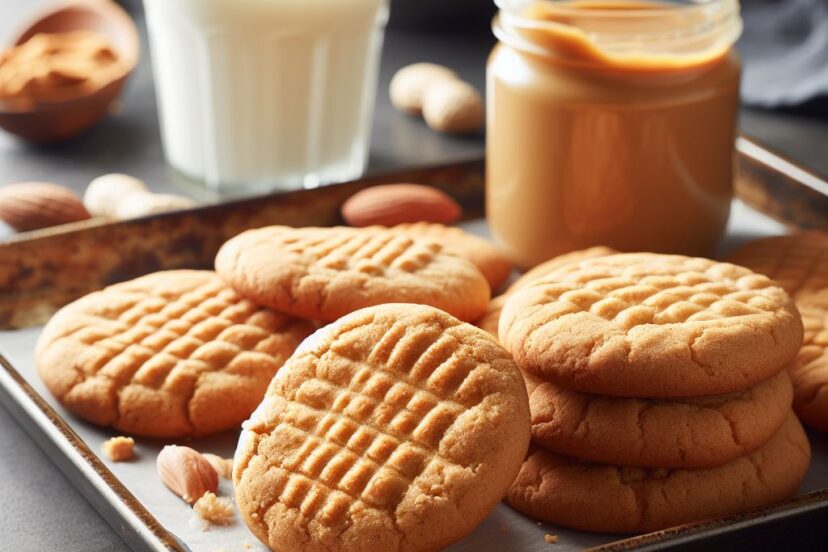Ketogenic Peanut Butter Cookies: Keto-Friendly Treat
*We may earn a commission for purchases made using our links. Please see our disclosure to learn more.
Ketogenic Peanut Butter Cookies: A Simple Guide to Low-Carb Baking
As someone who follows a ketogenic lifestyle, I’m constantly on the lookout for ways to enjoy treats that align with my low-carb, high-fat diet. That’s why I appreciate the simplicity and satisfying richness of ketogenic peanut butter cookies. These cookies are not just a way to indulge without breaking my carb limit; they also encapsulate the health-conscious approach of a keto diet. With an emphasis on minimizing sugar and using alternative flours, they offer a dessert option that fits perfectly into a balanced keto meal plan.

I understand the challenges of resisting sugary temptations, especially when it comes to baked goods. This is where keto peanut butter cookies come in as a game changer. They’re typically made with ingredients like almond flour or another nut-based alternative, sugar substitutes such as erythritol or stevia, and of course, natural peanut butter which is both nutritious and naturally low in carbohydrates. The result is a chewy, comforting cookie that satisfies sweet cravings without spiking my blood sugar levels.
My approach to making these cookies is all about keeping it simple and focusing on the quality of ingredients. By selecting a peanut butter with no added sugars and a natural sweetener with a low glycemic index, I enjoy cookies that are not only keto-friendly but also beneficial for my overall health. This handcrafted treat aligns with my lifestyle goals, ensuring that I can savor every bite with peace of mind.
Understanding the Keto Diet

In my exploration of dietary patterns, I have found the ketogenic, or “keto,” diet to be particularly intriguing due to its focus on high fat, moderate protein, and low carbohydrate intake. It’s a diet that reprograms the body to burn fat for fuel.
Basics of Keto
The keto diet revolves around a macronutrient breakdown typically comprising about 70% to 80% fat, 15% to 25% protein, and only 5% to 10% carbohydrates. This distribution drastically lowers one’s daily intake of carbs to around 20 to 50 grams, forcing the body into a state of ketosis. During ketosis, the body becomes more efficient at burning fat for energy.
- Net Carbs: This concept is crucial in keto, where you calculate net carbs by subtracting fiber from the total carbs, helping stay within the daily carb limit.
- Fats: Emphasized are healthy fats from sources like avocados, while trans fats are avoided.
Health Benefits
Research has documented several potential benefits of adhering to a ketogenic lifestyle. It’s essential to note that these results may vary:
- Weight Loss: By using fat as the primary energy source, the body may burn more fat for weight loss.
- Blood Sugar Control: Lowering carb intake can help stabilize blood glucose levels, which might be beneficial for those with type 2 diabetes.
- Improved Mental Clarity: Some individuals report enhanced mental clarity and focus while on a ketogenic diet.
My approach to discussing keto values accuracy, ensuring that I provide information aligned with current nutritional understanding. It’s crucial not to overstate claims and recognize that individual health outcomes can differ.
Key Ingredients for Ketogenic Peanut Butter Cookies

When making ketogenic peanut butter cookies, my selections focus on maintaining a low-carb profile while ensuring rich flavor. Let’s look at the essential components that fit perfectly into a keto-friendly pantry.
Choosing the Right Peanut Butter
I prefer natural, sugar-free peanut butter for its pure taste and health benefits. The ideal peanut butter should have one or two ingredients: peanuts and perhaps a bit of salt. Avoid peanut butter with added sugars or hydrogenated oils, as these can disrupt the ketosis process. Creamy peanut butter works best for a smooth texture in cookies, but if you fancy a bit of crunch, opting for a crunchy variety is also fine.
Selecting a Keto-Friendly Sweetener
Sweeteners are a tricky business on keto, but I have found monk fruit sweetener to be an excellent option. It does not impact blood sugar levels, and its sweetness is remarkably similar to that of sugar, enabling the cookies to have a familiar flavor profile. Erythritol and stevia are also viable choices, provided you adjust for sweetness potency, as they can be considerably sweeter than sugar.
Flour Alternatives for Ketogenic Peanut Butter Cookies
Given that traditional flour is off-limits for keto, I use almond flour in my recipes. It’s not only nutritious but also keeps the cookies within the low-carb threshold. Starting with about a 1:1 substitution ratio compared to regular flour, almond flour offers a mild, nutty flavor that complements the peanut butter beautifully without adding unwanted carbs.
In following these key ingredient guidelines, the nutrition info for each batch of cookies remains aligned with ketogenic dietary principles while still delivering delectable, satisfying treats.
Step-by-Step Baking Guide for Ketogenic Peanut Butter Cookies

In this guide, I’ll walk you through the precise steps for preparing the keto peanut butter cookie dough and the baking process. You’ll need a few kitchen essentials, such as an oven, cookie scoop, parchment paper, and a baking sheet.
Preparing the Dough
First I ensure all my ingredients are measured accurately. I start by softening cream cheese to room temperature, which will make it easier to blend. I crack an egg into a separate bowl—this helps prevent shell fragments from getting into the dough.
Next, I combine the egg with the peanut butter, keto-friendly sweetener, and baking soda in a large mixing bowl. If enhancing flavor is my goal, I incorporate a pinch of salt and a bit of vanilla extract. I mix these ingredients until my dough is evenly mixed, making sure there are no lumps of cream cheese or pockets of dry ingredients.
Baking Process
Before I begin forming the cookies, I preheat my oven to 350 degrees Fahrenheit (177 degrees Celsius) to ensure it’s ready.
Then, I prepare my baking sheet by lining it with parchment paper. This prevents sticking and makes cleanup much easier. Using my cookie scoop, I portion the dough into uniform balls and arrange them on the baking sheet, leaving enough space between each for even cooking.
I then press down on the top of each dough ball with a fork to create a classic criss-cross pattern. This not only gives them their characteristic peanut butter cookie appearance but also helps them cook through more evenly.
I bake the cookies for about 10-15 minutes or until the edges start to turn golden. Once done, I remove the cookies from the oven and allow them to cool on the baking sheet for a few minutes before transferring them to a wire rack. This step is crucial for the cookies to set properly.
For storage, I keep the cookies in an airtight container to maintain their freshness. If I want to keep them longer, I make sure they’re completely cool before placing them in the freezer.
Nutritional Profile and Adjustments

When crafting ketogenic peanut butter cookies, I pay close attention to the nutritional content, ensuring that the recipe aligns with keto dietary standards such as being low in carbohydrates and high in healthy fats.
Calorie Count and Macros
Calories: The calorie count per cookie generally hovers around 100-200 calories, depending on the size and ingredients.
Macros: A standard keto peanut butter cookie recipe typically looks like this:
- Total Fat: Typically 8-10g, which comes from sources like peanut butter and possibly added almond flour.
- Total Carbohydrate: Usually around 3-5g with an emphasis on minimizing net carbs.
- Dietary Fiber: Around 1-2g if almond flour or flaxseed meal is used.
- Sugars: I aim for less than 1g, employing sweeteners like erythritol or allulose to avoid sugar-induced spikes in blood glucose levels.
Table: Keto Peanut Butter Cookie Macro Breakdown
| Nutrient | Amount per Cookie (Approx.) |
| Calories | 100-200 |
| Total Fat | 8-10g |
| Total Carbohydrate | 3-5g |
| Dietary Fiber | 1-2g |
| Sugars | <1g |
Making Substitutions
For individuals with specific dietary needs or preferences, adjustments to the traditional recipe may be necessary.
- Sweeteners: I often substitute traditional sugar with low-carb options like allulose or erythritol to ensure the cookie stays keto-friendly without sacrificing sweetness.
- Flours: If someone is allergic to almonds, coconut flour can be used instead of almond flour, but keep in mind this will alter the texture and it’s more absorbent, so less is needed.
- Eggs: For those who avoid eggs, a flax egg (a mixture of ground flaxseed and water) can serve as a vegan alternative. This also adds fiber, which is beneficial on a keto diet.
- Fats: It’s critical to maintain a high-fat content, which is why natural, sugar-free peanut butter is my primary ingredient. It’s possible to boost the fat by adding ingredients like cream cheese, as seen in some recipes, if more moisture is desired.
Storing and Serving Suggestions

After crafting a batch of keto-friendly peanut butter cookies, I ensure they remain fresh and delightful for my enjoyment. My focus here is to maintain their texture and flavor through proper storage and to serve them in a way that accentuates their homemade quality.
Optimal Storage
- Temperature: I store the cookies in an airtight container to keep them fresh. For a short term option, I keep them at room temperature for up to one week. If I need to store them for a longer period, I place them in the fridge, which extends their life to about two weeks.
- Avoiding Sogginess: To prevent them from getting soggy, I sometimes add a piece of bread in the container, which helps to absorb excess moisture.
- Freezer Method: For long-term storage, I wrap the cookies individually in cling film and then put them in a container, which I then place in the freezer, where they can last for up to 3 months. When I want to enjoy them, I simply allow them to thaw at room temperature.
Serving Tips
- Room Temperature: I always take the cookies out of the fridge ahead of time to bring them to room temperature before serving. This ensures the flavors are more pronounced and the texture is as intended.
- Reheating: If I prefer them a bit warm, I reheat the cookies on a cookie sheet in a preheated oven at 300 degrees Fahrenheit for about 5 minutes. This brings back the crispness to the edges and soft warmth to the center.
- Presentation: To make them visually appealing, I ensure that the fork marks made before baking are visible as they serve as a classic hallmark of peanut butter cookies.
- Pairings: As for pairings, I find that serving the cookies with a glass of almond milk or a cup of keto-friendly coffee complements their rich, nutty flavor perfectly.
Expanding Your Keto Dessert Repertoire
I find that variety is key to staying satisfied on a ketogenic diet, and incorporating varied desserts helps maintain interest and enjoyment in the diet. It’s important to remember that a keto dessert can be just as delicious as traditional ones while keeping you aligned with your nutritional goals.
Variations and Related Treats
When crafting keto desserts, the substitutions used to maintain a low carbohydrate content are crucial. For Ketogenic Peanut Butter Cookies, I use almond flour in place of traditional wheat flour and a keto-approved sugar substitute to provide the necessary sweetness without the added carbs. There are several related treats I like to keep in my rotation:
- Keto Chocolate Chip Cookies: By simply adding sugar-free chocolate chips to the peanut butter cookie dough, I get a delightful variation that satisfies chocolate cravings.
- Coconut Flour Treats: If allergens are a concern, or I’m looking for a different texture, I opt for coconut flour, which creates a lighter, more cake-like treat.
- Keto-friendly Brownies: For a more decadent dessert, I incorporate cocoa powder into my batter, making rich and fudgy brownies that are surprisingly low in carbs.
Pairing with Other Keto Foods
To create a complete dessert experience, I often think about how my keto treats will pair with other keto-friendly foods. This consideration is especially important when I’m entertaining family or friends who follow a ketogenic lifestyle. Here’s how I like to pair my desserts:
| Keto Dessert | Pairing Ideas |
| Peanut Butter Cookies | A glass of unsweetened almond milk or a dollop of sugar-free whipped cream |
| Chocolate Chip Cookies | A bowl of fresh raspberries or a keto coffee to enhance the richness |
| Coconut Flour Treats | A scoop of keto-friendly ice cream for contrast in flavors and textures |
| Keto-friendly Brownies | A handful of pecans or walnuts for added crunch and nutritional value |
Ensuring the dessert complements the accompanying food enhances the overall meal without compromising the dietary requirements of the keto lifestyle.
Frequently Asked Questions
In this section, I address some common queries about preparing keto-friendly peanut butter cookies. You’ll find practical tips for making them flourless, egg-free, and with minimal ingredients.
1. What are some flourless options for making ketogenic peanut butter cookies?
For a flourless ketogenic peanut butter cookie, simply omit any type of flour or alternative flour products. The cookies typically consist of peanut butter, a keto-friendly sweetener, and sometimes an egg to bind. The result is a dense, satisfying cookie that suits a ketogenic diet.
2. How can I make ketogenic peanut butter cookies without eggs?
If you need to make your peanut butter cookies without eggs, consider using a binding substitute like cream cheese, almond butter, or even a “flax egg” (ground flaxseeds mixed with water). These ingredients can help hold the cookie together without adding carbs.
3. What is the recipe for 3-ingredient ketogenic peanut butter cookies?
The simplest 3-ingredient recipe for keto peanut butter cookies involves mixing peanut butter with a sweetener like erythritol and an egg. Combine these ingredients, form the cookies, and bake them at 350°F (180°C) until golden brown.
4. Can almond flour be used in keto peanut butter cookies, and how does it change the recipe?
Yes, almond flour can be used in keto peanut butter cookies. It offers a more traditional cookie texture and helps manage moisture. You would typically add about 1/4 cup of almond flour to your peanut butter and sweetener mixture to achieve a dough-like consistency.
5. Which peanut butter brands are recommended for a ketogenic diet, and why?
Opt for natural, unsweetened peanut butter brands that have no added sugars or oils. These fit well within a ketogenic diet as they focus on high-fat, lower-carb content, essential for maintaining ketosis. Brands that specify “no added sugar” or “all-natural” are usually suitable choices.




